| Pages:
1
..
4
5
6
7 |
ecos
Hazard to Others
  
Posts: 464
Registered: 6-3-2014
Member Is Offline
Mood: Learning !
|
|
It looks so nice.
did you try to measure the current? why don't you use a power meter to monitor Voltage, current and power?
from my experience , the voltage and current on the cell will drop after long running time due to different reasons:
1- the temp on the supply rise; voltage will drop down. you can use a small computer fan to solve this prob
2- conc. salts will decrease in electrolyte ; conductivity decrease; current decrease. you can add more salt 
just don't get surprised , this is normal.
|
|
|
greenlight
National Hazard
   
Posts: 763
Registered: 3-11-2014
Member Is Offline
Mood: Energetic
|
|
Thankyou.
I am looking into purchasing a voltmeter/ampmeter to measure the current flowing through it.
It has been running for 45 hours now and some of the electrolyte was evaporated today and the crystals mixed with sugar. The mixture smoldered and
almost maintained deflagration on its own which indicates the presence of chlorate oxidiser.
[Edited on 2-11-2016 by greenlight]
|
|
|
ecos
Hazard to Others
  
Posts: 464
Registered: 6-3-2014
Member Is Offline
Mood: Learning !
|
|
Good news
It is better to buy something like this :
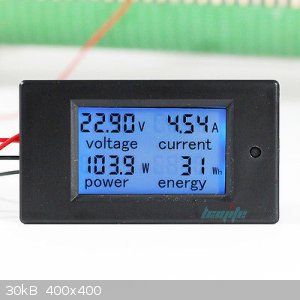
Ref : http://m.ebay.com/itm/100A-DC-Digital-Watt-KWH-Current-Power...
[Edited on 2-11-2016 by ecos]
|
|
|
yobbo II
National Hazard
   
Posts: 777
Registered: 28-3-2016
Member Is Offline
Mood: No Mood
|
|
The cells looks exquisit. It's like a piece of David Bowie art!
If you could purchase a coulumb meter (amper hour meter) that would be great.
|
|
|
Laboratory of Liptakov
International Hazard
    
Posts: 1447
Registered: 2-9-2014
Location: Tel Aviv University
Member Is Offline
Mood: old jew
|
|
I see excellent results and work describe from ecos and greenlight about preparation NaCl =O3=O4. Plastic explosive on NaClO4 base will be early !
Thanks behind your work and invention.
Dr...:-)
Development of primarily - secondary substances: CHP (2015) neutral CHP and Lithex (2022) Brightelite (2023) Nitrocelite and KC primer (2024) Diper
60 (2025)
|
|
|
greenlight
National Hazard
   
Posts: 763
Registered: 3-11-2014
Member Is Offline
Mood: Energetic
|
|
Thanks guys 
Yes, I will look for and amphour meter voltmeter to meaure the current so I can get an accurate runtime.
|
|
|
ecos
Hazard to Others
  
Posts: 464
Registered: 6-3-2014
Member Is Offline
Mood: Learning !
|
|
If you want to get a better results with easy steps:
1- use stirrer.
2- get the electrodes closer. this will increase the current. you have a very good power supply (20A) so don't get afraid
3- get a 6v power supply.
I don't know why I like to see high currents in the cells.
it is better to calculate the max current that the electrode can operate on and operate at 80% from it.
[Edited on 4-11-2016 by ecos]
|
|
|
greenlight
National Hazard
   
Posts: 763
Registered: 3-11-2014
Member Is Offline
Mood: Energetic
|
|
I have heard of using a stirrer before and will consider it if I end up making a 5 litre potassium chlorate cell.
The electrodes are about 1 inch apart in the current cell. I would put them closer but then I would need a cooling bath probably because the
electrolyte would get too hot.
My first preference was a 6 volt power supply but I could not find a unit like the one I purchased in 6 volt with an acceptable amperage.
|
|
|
ecos
Hazard to Others
  
Posts: 464
Registered: 6-3-2014
Member Is Offline
Mood: Learning !
|
|
here we go  : http://www.ebay.de/itm/131486861965 : http://www.ebay.de/itm/131486861965
|
|
|
greenlight
National Hazard
   
Posts: 763
Registered: 3-11-2014
Member Is Offline
Mood: Energetic
|
|
Nice find, you can customise your power supply.
They didn't come up for me when I was looking as they aren't in english I think.
|
|
|
ecos
Hazard to Others
  
Posts: 464
Registered: 6-3-2014
Member Is Offline
Mood: Learning !
|
|
any updates about perchlorate?
|
|
|
greenlight
National Hazard
   
Posts: 763
Registered: 3-11-2014
Member Is Offline
Mood: Energetic
|
|
I am awaiting arrival of an lcd display ammeter before running any further so I can get an idea of finish times.
I have done about 100 hours so far.
|
|
|
greenlight
National Hazard
   
Posts: 763
Registered: 3-11-2014
Member Is Offline
Mood: Energetic
|
|
I have been busy with work and have only just got around to installing the digital ammeter.
I decided to use an old wooden pallet and some spare pieces of wood sheeting to form a dodgy table for the whole thing with the cell on one side and
the electronics on the other with a dividing wall to mount the meter. The attached picture if of the electronic side
The last of the wiring has to be put in and it will be ready to run
[Edited on 19-3-2017 by greenlight]
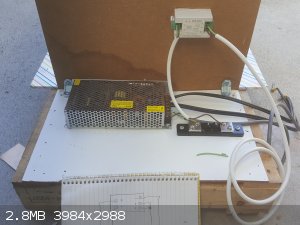
|
|
|
Laboratory of Liptakov
International Hazard
    
Posts: 1447
Registered: 2-9-2014
Location: Tel Aviv University
Member Is Offline
Mood: old jew
|
|
anodes
OK.....devil's device....I am curious..... .....LL .....LL
Still short questions:
1) For example on 1 liter solution you recommend kathode (-) can be from stainless steel ? For example stainless cup ?
2) As anode (+) for chlorates (xClO3) is best what ? Titanium reactive surface? PbO2 reactive surface ?
3) How large surface anode for 1 liter? 2x3 inch or 2x4 inch ? (5x7,5cm - 5x 10cm) ---sieve mesh type
Thanks..... ...LL ...LL
[Edited on 20-3-2017 by Laboratory of Liptakov]
[Edited on 20-3-2017 by Laboratory of Liptakov]
Development of primarily - secondary substances: CHP (2015) neutral CHP and Lithex (2022) Brightelite (2023) Nitrocelite and KC primer (2024) Diper
60 (2025)
|
|
|
markx
National Hazard
   
Posts: 650
Registered: 7-8-2003
Location: Northern kingdom
Member Is Offline
Mood: Very Jolly
|
|
Quote: Originally posted by Laboratory of Liptakov  | OK.....devil's device....I am curious..... .....LL .....LL
Still short questions:
1) For example on 1 liter solution you recommend kathode (-) can be from stainless steel ? For example stainless cup ?
2) As anode (+) for chlorates (xClO3) is best what ? Titanium reactive surface? PbO2 reactive surface ?
3) How large surface anode for 1 liter? 2x3 inch or 2x4 inch ? (5x7,5cm - 5x 10cm) ---sieve mesh type
Thanks..... ...LL ...LL
[Edited on 20-3-2017 by Laboratory of Liptakov]
[Edited on 20-3-2017 by Laboratory of Liptakov] |
Cathode material for ClO3- electrosynthesis can be made from stainless steel, titanium or even regular mild steel. If I remember correctly then mild
steel (iron) had the lowest overpotential for hydrogen evolution and hence is the most economical option in terms of energy loss, but for amateur use
it makes really no difference. I think stainless is the best option for amateur use....widely available and rather cheap. Current density on cathode
is not critical.
As for anode the best option is by far MMO. The next best in terms of availability is graphite, but one has to remember that it erodes and wears away
in a chlorate cell and contaminates the cell liqour with carbon particles that have to be filtered out in a separate step. Graphite is especially
susceptible to erosion under cell liqour temperatures above 40C and excessive current density, but if used in mild conditions it can serve for quite a
period of time.
As for the current density on anode...it is a most critical parameter that influences the longevity of the anode directly. For MMO it should be on the
order of 0,25A/cm2, but it also depends on the particular MMO composition and there are many. Lower is better in terms of longevity of the anode. For
graphite only about 0,1A/cm2 is suggested.
Exact science is a figment of imagination.......
|
|
|
greenlight
National Hazard
   
Posts: 763
Registered: 3-11-2014
Member Is Offline
Mood: Energetic
|
|
@ Laboratory of liptakov
1. The cathode I am using is titanium plate.
2. The anode is MMO layer coated in titanium mesh
3. The anodes are both 2x6 inch in size and are fully submerged when the 2.2 liter cell is full.
The power supply is 5 volt 20 amp and I nearly have it all wired up, just need some heat shrink wrap around the connections to the ammeter and fit the
cell leads.
|
|
|
yobbo II
National Hazard
   
Posts: 777
Registered: 28-3-2016
Member Is Offline
Mood: No Mood
|
|
If you want your graphite to last you must control pH of cell (add HCl acid).
|
|
|
Laboratory of Liptakov
International Hazard
    
Posts: 1447
Registered: 2-9-2014
Location: Tel Aviv University
Member Is Offline
Mood: old jew
|
|
Thanks, boys for your experiences.....and for others, of course it are important values......I will using on NaClO3 Two pure titanium flat plate 2 mm
thick grade 1 purity. For better counting of current, thus 0,25 A on cm2. In this set is possible reverse polarity. Even is impossible making error in
polarity.../huhaha/.....
On 2,2 liter only 20 Amp ? OK...is not voltage much high 5 V ? I read some here even 3,5 - 4,5 Volts max. But higher current. OK, I Believe in your
experiences, thanks............ ..........LL ..........LL
Development of primarily - secondary substances: CHP (2015) neutral CHP and Lithex (2022) Brightelite (2023) Nitrocelite and KC primer (2024) Diper
60 (2025)
|
|
|
greenlight
National Hazard
   
Posts: 763
Registered: 3-11-2014
Member Is Offline
Mood: Energetic
|
|
20 amp has been fine in the 100 hours the cell has done to raise the temperature to 70 C which is perfect temp for chlorate production.
Once I can work out when all of the chloride has been turned to chlorate using the ammeter , I will switch out the MMO anode with a platinized one to
convert to perchlorate.
|
|
|
Laboratory of Liptakov
International Hazard
    
Posts: 1447
Registered: 2-9-2014
Location: Tel Aviv University
Member Is Offline
Mood: old jew
|
|
OK, Green, thanks, Cell running only 4 days ? Very good result. It seems on efficiency almost 100%. Thus according this calculator: http://www.vk2zay.net/calculators/?body=chlorates.php
Estimate your cell has 700g NaCl on start procedure. Be that as it wants, NaClO4 is holy grail of all deminers. For next conversions.... ...LL ...LL
Development of primarily - secondary substances: CHP (2015) neutral CHP and Lithex (2022) Brightelite (2023) Nitrocelite and KC primer (2024) Diper
60 (2025)
|
|
|
markx
National Hazard
   
Posts: 650
Registered: 7-8-2003
Location: Northern kingdom
Member Is Offline
Mood: Very Jolly
|
|
Quote: Originally posted by Laboratory of Liptakov  | Thanks, boys for your experiences.....and for others, of course it are important values......I will using on NaClO3 Two pure titanium flat plate 2 mm
thick grade 1 purity. For better counting of current, thus 0,25 A on cm2. In this set is possible reverse polarity. Even is impossible making error in
polarity.../huhaha/.....
On 2,2 liter only 20 Amp ? OK...is not voltage much high 5 V ? I read some here even 3,5 - 4,5 Volts max. But higher current. OK, I Believe in your
experiences, thanks............ ..........LL ..........LL |
I hope you are not trying to use titanium metal as the anode for the chlorate cell....this will not work. Titanium will passivate under anodic
potential and become unconductive, not to mention that it is unable to convert Cl- to ClO3-. Ti can only be used as the cathode.
Only MMO coated titanium can be used as the anode....or any of the alternatives suggested above: graphite, platinum, lead dioxide and some other oxide
based anodes. The only viable options from practical side are MMO and graphite to be honest.
Cell voltage of 5V is plenty enough for most usual electrosynthesis applications, including chlorate conversion. The voltage applied to the cell will
only have to overcome the electrochemical potential of the cathodic and anodic reactions plus their overvoltage (depending mostly on electrode
material) and for the chlorate synthesis this summary potential lies at about 3,5V. The rest of voltage applied to the cell will be dropped on the
negligible ohmic resistance of the electrolyte (and other circuit components) U=I*R and evolve as excessive heat in the electrolyte. So from this it
can be seen that a slight increase in the applied voltage will drastically increase the current running through the cell. To avoid excessive current
density at the anode one has to have a means to regulate the applied voltage or the distance between electrodes in the cell. Most efficient way of
course is to regulate the voltage....most contemporary switching power supplies have a means to regulate the output voltage.
For 2,2l cell under optimum applied voltage a 20A current is quite ok. I run a 5l cell at about 3,7-4,2V 40-50A and the electrolyte temperature will
rise to 70-75C under natural cooling. This is quite optimal for a MMO setup, but go any higher with the current and the cell will reach boiling
temperature quickly, electrolyte will evaporate, things overheat and it just becomes a huge mess.
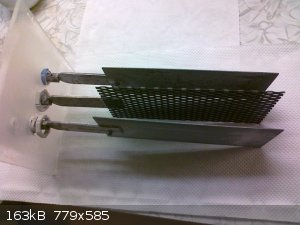 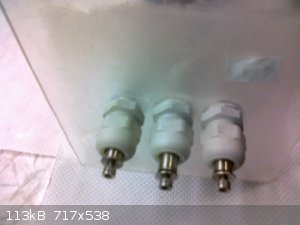 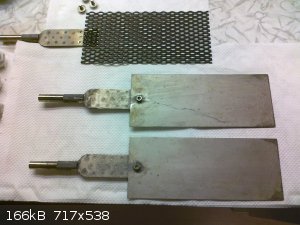 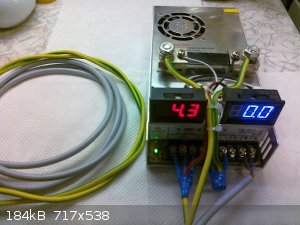 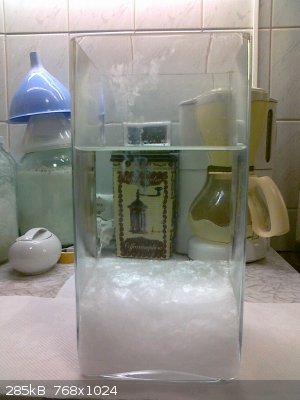
Exact science is a figment of imagination.......
|
|
|
Laboratory of Liptakov
International Hazard
    
Posts: 1447
Registered: 2-9-2014
Location: Tel Aviv University
Member Is Offline
Mood: old jew
|
|
Fantastic aparatus. Both cathodes thus are stainless plates, between is one titanium sieve with surface from multi metal oxides - MMO. Respectively
Iridium oxid and Rhutenium oxid and maybe Titanium oxid are on surface. OK.
I will making almost same construction. Tube /rod output with electric plastic plug is ingenious for replacement - recovery. Well...size cathodes
large - surface is not important. Can be 2x or 4x bigger than anode. Or all container can be from stainless steel as kathode. For better cooling.
Container is also possible pose in bucket with water and use two 12V fans whiff on level in bucket. After is possible increase current on maximum
permission, not voltage of course. OK. It Seems nice. Now still somewhere find MMO. Thanks for important details.............. ........LL ........LL
[Edited on 24-3-2017 by Laboratory of Liptakov]
Development of primarily - secondary substances: CHP (2015) neutral CHP and Lithex (2022) Brightelite (2023) Nitrocelite and KC primer (2024) Diper
60 (2025)
|
|
|
ecos
Hazard to Others
  
Posts: 464
Registered: 6-3-2014
Member Is Offline
Mood: Learning !
|
|
you can use SS nails/bolts. they also work fine and very cheap.
don't forget to clean them with sand paper every day because something sticks on it from the cell.
I don't know if it is oxidation or what !
|
|
|
greenlight
National Hazard
   
Posts: 763
Registered: 3-11-2014
Member Is Offline
Mood: Energetic
|
|
metered perc cell update
I wired the whole system together and ran it but the amps are reading wrong.
With some help from WSM from the apc forum the cause is found to be that the meter is max 200 amp and the shunt is only 20 amp. I need to match the
meter amperage with the shunt amperage for the system to be accurate.
[Edited on 1-4-2017 by greenlight]
|
|
|
ecos
Hazard to Others
  
Posts: 464
Registered: 6-3-2014
Member Is Offline
Mood: Learning !
|
|
are u going to drive more than 20 amp in the shunt ?!if yes, the anode will be destroyed with much current.
I advised you in the beginning to use power meter since you just connect its cables and avoid those mismatches 
anyway , good luck 
|
|
|
| Pages:
1
..
4
5
6
7 |